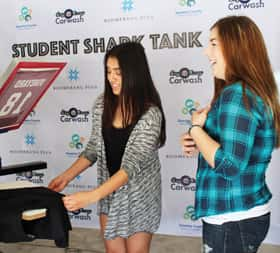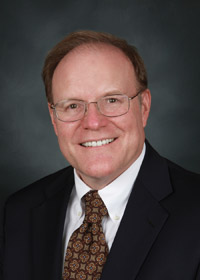 A few years ago, the national goal for secondary education moved away from the idea of “preparing students for college or careers” and adopted the goal of college and career readiness for all students. This critical shift in wording brings significant changes as schools redesign their systems. At the high school level, Career Technical Education (CTE) programs have been the go-to resource for preparing students for their eventual entry into the work world. This is still the core purpose of CTE, but these programs have taken on new responsibilities in recent years.
A few years ago, the national goal for secondary education moved away from the idea of “preparing students for college or careers” and adopted the goal of college and career readiness for all students. This critical shift in wording brings significant changes as schools redesign their systems. At the high school level, Career Technical Education (CTE) programs have been the go-to resource for preparing students for their eventual entry into the work world. This is still the core purpose of CTE, but these programs have taken on new responsibilities in recent years.
In helping students prepare for their future, Chuck Wade, CTE program coordinator for Sonoma County Office of Education (SCOE), says, “Curriculum integration makes students more interested in school and their community. It gives them a sense of how adults in their community use what they are studying in school.”
By “curriculum integration,” Wade means learning concepts from courses such as English, math, history and science in the context of meaningful projects that are similar, if not identical to, the kinds of things adults do in the course of their working lives. This can include internships and other work-based learning opportunities that lower the classroom walls and bring student learning into the real world. At their best, these types of programs broaden students’ perspectives and boost their confidence. One local program that delivers on both counts is Boomerang Plus.
“When we connect students with businesses, we build stronger communities. This is what we call The Boomerang Plus Effect.” says David Hamelburg, founder of Boomerang Plus, a 501(c)(3) nonprofit that teaches Sonoma County students real world job skills. The program includes internships that let participants explore local businesses and gain hands-on work experience. It’s valuable knowledge that helps them understand what it takes to run a business. They see what skills they have and what skills they need to develop to be successful in their own lives. Hamelburg believes that students, particularly those about to graduate high school, need to understand not only business skills and expectations, but also the importance of integrity in the business world.
The Boomerang Plus Effect.” says David Hamelburg, founder of Boomerang Plus, a 501(c)(3) nonprofit that teaches Sonoma County students real world job skills. The program includes internships that let participants explore local businesses and gain hands-on work experience. It’s valuable knowledge that helps them understand what it takes to run a business. They see what skills they have and what skills they need to develop to be successful in their own lives. Hamelburg believes that students, particularly those about to graduate high school, need to understand not only business skills and expectations, but also the importance of integrity in the business world.
Start with an idea
With a bachelor’s degree in finance from The College of William and Mary in Virginia, Hamelburg spent two years working as an investment executive/stock broker on Wall Street before moving to Hawaii in 1998. There, he launched Aloha Custom, a custom logo wear business. He developed three basic core values: integrity, dependability and social entrepreneurship. It was his dedication to these principles that helped the company become a leader in its industry.
After meeting and marrying Jennifer Becnel, a Sonoma County native, the couple moved their business to Windsor in 2002. Hamelburg started an internship program for students at Aloha Custom in 2012 with the goal of providing hands-on business experience to better prepare them for college and the workforce. In 2014, he founded Boomerang Plus.
 According to Wade, who works with Hamelburg in an advisory capacity, the internship experience is an essential component of Boomerang Plus. Boomerang Plus partners with high schools and career development programs to teach essential job skills to local students. The internship covers a vast array of topics, including marketing, graphic design, finance, customer service, team building, communication, appropriate dress and appearance, presentation skills and giving back to the community. Students participate in the production and sale of screen printed T-shirts, bags, spiritwear and promotional products for schools, businesses, and nonprofits.
According to Wade, who works with Hamelburg in an advisory capacity, the internship experience is an essential component of Boomerang Plus. Boomerang Plus partners with high schools and career development programs to teach essential job skills to local students. The internship covers a vast array of topics, including marketing, graphic design, finance, customer service, team building, communication, appropriate dress and appearance, presentation skills and giving back to the community. Students participate in the production and sale of screen printed T-shirts, bags, spiritwear and promotional products for schools, businesses, and nonprofits.
Students interact with clients and learn about things like sales, production and budgeting. A “Students Brandz” display at the Raley’s grocery store in Windsor includes T-shirts and hats silk screened by the students. Store manager John Moore says, “The display represents our community and we’re always in need of products for it.”
The first year of internships had 6 students. In 2016, the goal is to have 50. The program lasts for one year, consisting of 20-30 hours of work in total. There’s approximately 10 hours of discovery, which includes researching different companies and nonprofits, visiting various businesses and organizations, and listening to guest speakers. Then another 10 hours of experience, which includes graphic design, developing marketing campaigns, financial analysis, and helping make products. The last 10 hours of the program are spent learning about entrepreneurship, best business practices and ethics along with in-depth discussions on what’s needed to run a business. Guest speakers and hands-on experiences are tailored to student interests.
Confidence and understanding
Gabriela “Gabby” Flores, 18, was a junior at Healdsburg High School when she interned at Aloha Custom (HHS requires all students to complete an internship prior to graduation). For three weeks, she and 5 other students met two times per week, one third of which in the Boomerang Plus program, and received class credit. A bit on the shy side, Flores says her involvement in the program gave her more confidence in her ability to interact with others and also improved her public speaking skills. Part of her experience included working with computers, setting up a professional website, marketing and learning about target markets.
Flores was most proud of developing a website for Healdsburg High School’s Parent and Teachers Organization (PTO) and seeing them use the end product. “Working with David Hamelburg was a great experience, and being part of the program inspired me to continue with my education,” she says. Following graduation earlier this year, Flores has chosen to pursue a career in the wine industry.
As Boomerang Plus interns, students visit multiple businesses to learn how they operate and hear the owner’s personal experience, including how he or she got started and some of the challenges they’ve faced. At Scandia Family Fun Center in Rohnert Park and Snoopy’s Home Ice in Santa Rosa, interns got a behind-the-scenes tour to learn how the businesses are run and what the companies look for when hiring; they also participated in a team building exercise on Scandia’s miniature golf course. Other participating businesses include Exchange Bank and Redwood Credit Union, where students learned about banking and finance, and Santa Rosa Junior College, where they were encouraged to explore different career options and requirements for certificates or degrees.
In 2014, Healdsburg High School’s internship program was awarded the Golden Bell Award, presented by the California School Board Association, which recognizes innovative programs in California schools that make a demonstrated difference for students.
Direct interaction
 Wade believes giving students an opportunity to talk with business professionals is essential for increasing students’ awareness of the kinds of careers they might wish to pursue, and for helping them to understand the path to get there. At the annual Spring Economic Forecast breakfast with the Sonoma County Economic Development Board (EDB) students manned a booth displaying their products and also sat with business owners at the breakfast, which gave them a sense of the business community. Four hundred businesspeople attended and, according to EDB Director Ben Stone, they were amazed to learn about the Boomerang students and the internship programs. The students’ presence, Stone said, demonstrated they were getting experience working with equipment and concepts that will help them be better prepared to be part of the labor movement of the 21st century.
Wade believes giving students an opportunity to talk with business professionals is essential for increasing students’ awareness of the kinds of careers they might wish to pursue, and for helping them to understand the path to get there. At the annual Spring Economic Forecast breakfast with the Sonoma County Economic Development Board (EDB) students manned a booth displaying their products and also sat with business owners at the breakfast, which gave them a sense of the business community. Four hundred businesspeople attended and, according to EDB Director Ben Stone, they were amazed to learn about the Boomerang students and the internship programs. The students’ presence, Stone said, demonstrated they were getting experience working with equipment and concepts that will help them be better prepared to be part of the labor movement of the 21st century.
Wade says teachers benefit as well, as the program is one part of a broader effort to bring curriculum integration organized around work-based learning to local high schools. Thanks to the internship program organizations like Boomerang Plus, teachers learn more about what their students need. Students then have a clearer idea of how adults use the skills they learned in school in the context of their work. “These kinds of relevant and authentic learning experiences for students are helping them to prepare for what they will be doing once they leave school,” Wade says.
Dive right in
For students interested in becoming entrepreneurs, Boomerang Plus’ Student Shark Tank experience lets them develop and pitch business ideas to investors. Based on the ABC reality television show, aspiring student-entrepreneurs make business pitches to a panel of “shark” investors, who then choose whether or not to support the idea financially. To be part of the program, students apply online at www.studentsharktank.com. The first step is to make a video of the project they want to pitch, including how much funding they’re requesting and how the money will be used. Videos are evaluated and voted on by Hamelburg and students in the intership program.
The first Shark Tank took place April 14, 2016, at the Lucchesi Park Recreation Center in Petaluma. Students presented their business ideas to Hamelburg, Darlene Walley, CEO of DRW Consulting; Matt Riveras owner of Easy Breezy Car Wash; and Scott Huberts with 5th Street Financial. After the student pitches, the sharks asked a variety of questions to investigate students’ claims and research.
Twenty applications were received and, of those, 13 were chosen to present. Six were selected to be funded in amounts ranging from $100 to $1,000. Of the six finalists, Hamelburg says some student enterprises are up and going, some are on hold and some were involved just for the experience (To date, none of the student ventures have actually received money from the sharks due to factors such as students going to college, not enough time or wanting to pursue other interests).
Among the questions asked were: Who is your competition? What experience have you had with the product up to this point? How do you plan to manufacture/produce your product i.e. will you need a kitchen, a warehouse or even an outside factory? What are your sales up to this point? What are you currently doing to sell your product? What type of marketing have you done? How much have you invested? How much additional monies will you need and what will the money be used for?
Walley was honored to be a shark and to coach students. As a business consultant, she says, “There are times I work with business owners who are struggling because they don’t have the skills these young people are already learning. Some owners don’t even have business plans. Knowing this information helps them to be more successful.”
She believes students who go through this program will be more prepared for the world of business with a perspective that will help them see what’s necessary to succeed. “It was a very rewarding process with both the members of the Shark Team along with the students to see how intelligent and prepared they all were,” she says.
Swimming with the sharks
Jesse Ochoa, 16, and Jario Gomez, 17, met during an entrepreneurship course at Casa Grande High School in Petaluma. One course requirement was to develop a product along with a business and marketing plan. Both believed mass market T-shirts are generally overpriced and are also a good way to communicate issues. Their project, called Good Kidz Apparel, had the goal of providing affordable T-shirts and coming up with a positive message to put on them. A lot of discussion had taken place in the school recently about drug abuse, which inspired the motto “We Don’t Need Drugs to Have Fun.” They produced 10 shirts and sold them all. Both saw that they had a good idea.
The pair heard about the Student Shark Tank and applied to the program. When Ochoa found out they were accepted, he was nervous but excited at the same time. They were excited to have the experience of doing a presentation and have their company evaluated. “At first we thought about getting money, but then we realized the experience itself was worth more than money,” says Ochoa. Both were familiar with the TV show and knew a presentation would be required. “At first, we were nervous about participating but we decided to go for it,” says Gomez, who remembers the idea of talking in front of a group was challenging. “I was nervous,” he admits, “but once the sharks starting asking questions and I saw their interest, I relaxed.”
The experience was rewarding and both saw it as an opportunity to see if their idea had merit. Gomez felt pride in talking about how much he had learned about running a business. Learning how to make a profit, create a budget and manage their money was challenging, but he learned how to manage his own business, buy materials and sell a product.
“It wasn’t as easy as I thought it would be,” says Gomez. “But I felt it was a privilege to go through the process. I was thankful for all I learned and would encourage others to do the same,” adds Ochoa, who adds, “Chase your dreams and if you want to have a business, do it with friends.” The next Student Shark Tank will take place in Windsor, October 2016 with more to follow in Sonoma, Napa, and Marin. The last one of the year will be held in Santa Rosa in December 2016.
In the book Children Learn What They Live, author Dorothy Law Nolte, Ph.D., wrote, “If children live with encouragement, they learn confidence. If children live with recognition, they learn it is good to have a goal. If children live with praise, they learn appreciation.” This sentiment sums up the importance of having programs like Boomerang Plus and the Student Shark Tank experience: “Our goal is to educate and motivate students to better prepare them for the transition from school to the work place,” says Hamelburg.
For more information about the Boomerang Plus Internship Program and the next Student Shark Tank, email david@boomerangplus.org.



